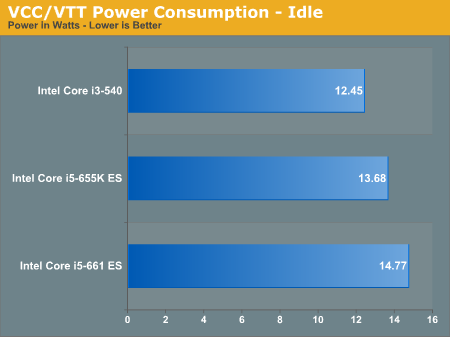Intel’s Core i5-655K & Core i7-875K: Overclocked and Analyzed
by Rajinder Gill on May 28, 2010 5:00 AM ESTHere's the idle/full load power consumption figures at stock speeds. VCC and VTT only, with VRM switching efficiency factored out:


Now that we've got these figures as a reference point. We can start looking at how each processor reacts to over-frequency conditions and how this affects factors such as heat and stability.
The following graph shows processor power scaling versus frequency, using Linpack to load the cores – highlighting the maximum Stock VID overclock and the maximum overall overclock using the Intel heatsink:

Using the BCLK method of overclocking (increasing the frequency of every associated bus), the power consumption ramp between 3.33GHz and 3.77 GHz is a mere 4 Watts at stock VID on our i5-655K – that’s why overclocking at stock voltages is wise if you’re working within the confines of stock cooling or concerned for processor longevity. In fact, only a small change in voltage is required to reach the 4GHz mark, coming in at a very sensible 7 Watt rise over stock power draw.
Over 4GHz, we see a sharp hike in power draw for every 20MHz increase in frequency, and by the time we get to 4.127GHz we’re tapped out on the stock Intel cooler. Increasing voltage at this point does not help, and we start seeing uncorrectable errors during Linpack. At this point, we need better cooling to extend our overclocking headroom. Before we experiment with improved cooling though, its worth taking a look at how things compare to a retail i3-540 using Intel’s stock heatsink.










51 Comments
View All Comments
Rajinder Gill - Saturday, May 29, 2010 - link
Hi,I ran out of time to test any further unfortunately. The emphasis was kept on air/water cooling because it's practical to run 24/7.
Regards
Raja
TheBLK - Saturday, May 29, 2010 - link
I'll ask again. Unless the screen shots are wrong you used BLK clock to over-clock rather than multiplier on the chip.Other reviews kept the BLK at the same value and just used the multiplier and seemed to get higher results.
Rajinder Gill - Saturday, May 29, 2010 - link
Yes I did on the 655-K stock VID (added 2 BCLK because the next multiplier up was too far (133 multiples in frequency is a large jump) :http://www.anandtech.com/show/3742/intels-core-i56...
Also describe why BCLK overclocking is not the way to go on the 655K for performance:
http://www.anandtech.com/show/3742/intels-core-i56...
Finally the 855K - this chip is limited to 4GHz even on water cooling. BCLK overclocking is not going to change that. 167 BCLK at DDR3 1670 is nowhere near stressful for the Lynnfield IMC. Multiplier overclocking is NOT going to make any difference to the clock speed limitation.
-Raja
Rajinder Gill - Saturday, May 29, 2010 - link
Just for you :)http://img7.imageshack.us/f/linpackfailj.jpg/
That is all the water loop can handle (the chip is drawing over 190W). I can drop the multiplier down to 30 (but then we are back to 4GHz).
Hope this helps!
Regards
Raja
DJMiggy - Thursday, June 3, 2010 - link
It seems like you guys used the wrong motherboard or got a dud i7. Other reviewers don't seem to be having as tough a time overclocking these higher.Rajinder Gill - Friday, June 4, 2010 - link
The motherboard is EVGA's E659 - works fine with my i7 870 ES taking it to 4.4GHz Linpack stable. It's the CPU that is the limiting factor here. Bear in mind that not all articles you've read will have stability checked stability with Linpack as well.Later
Raja
DJMiggy - Friday, June 4, 2010 - link
That makes sense. Cool thanks! I appreciate the explanation.ReaM - Saturday, June 5, 2010 - link
I must say, what a crappy K-series! I can bring every i7 860 up to 4ghz. I have tested many of them, so there is really no reason to put any hope into these Ks. Just buy a regular one.My personal sample of 860 runs @ 4200 with 1.29V on air Noctua U12 with low temps.
ReaM - Saturday, June 5, 2010 - link
Did you put Load Line Calibration into LVL2?I don't know what's that called on EVGA. Enhanced Power Slope. VDrop Adjustment. Lynnfield, unlike Bloomfield, likes their load line to be adjusted.
Rajinder Gill - Sunday, June 6, 2010 - link
Makes no difference to the stability of this chip.